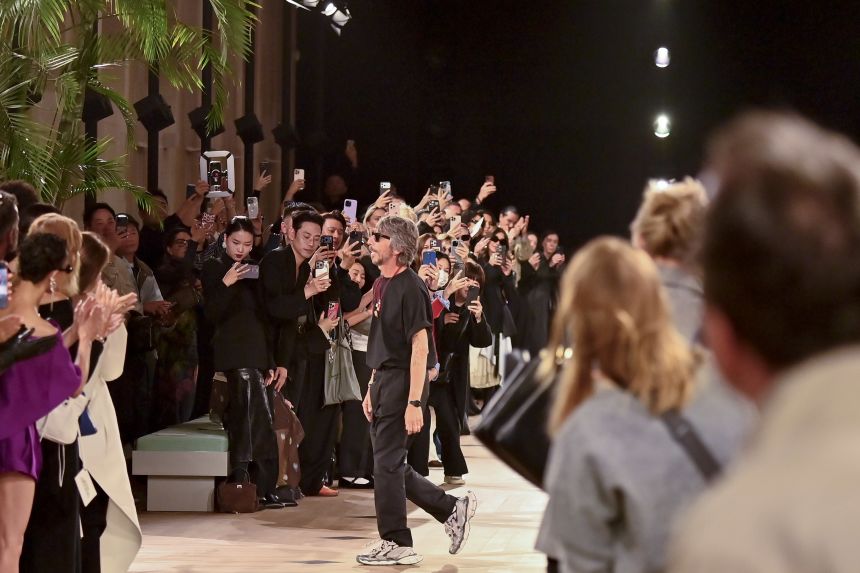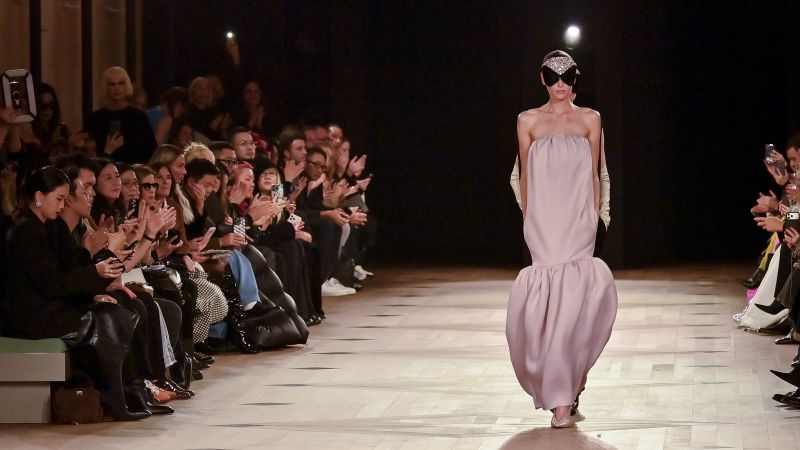Paris
—
When guests arrived for the Balenciaga show during Paris Fashion Week on Saturday evening, several found themselves on familiar ground: a chapel built during the reign of the former French King Louis XIII, which is part of the historic Laennec headquarters of Balenciaga’s owner, Kering. After all, it was only three months ago that a retrospective for the brand’s former designer, Demna (now at Gucci), took place here.
For Pierpaolo Piccioli, the creative director of the Paris-based luxury house as of July, it was important to acknowledge those who had come before him — and to return to the site that honored his predecessor’s achievements marked a full circle of sorts that made him comfortable to move forward, he told editors backstage after the show. It’s a gesture that encapsulates the kind of designer that Piccioli, who relocated to Paris from Rome for the job, has become known for: compassionate, humanist and kind.
Those attributes — earning Piccioli a reputation in fashion as one of its great romantics — were also apparent in his designs for Balenciaga, which incorporated plenty of thoughtful details that referenced the archive. They were shown for the first time to a starry front row that included the actors Anne Hathaway, Kristin Scott Thomas, and Krit Amnuaydechkorn (better known by fans as PP Krit), director Baz Luhrmann, and even Meghan Markle, the Duchess of Sussex — who, for her first-ever Paris Fashion Week show, wore a white cape draped across a silky shirt and floor-skimming trousers.
The opening look at Balenciaga was a long slinky black dress, styled with white gloves, pulled up past the elbows, and bedazzled wraparound visors that covered half the model’s face. Then came some tops and skirts in bulbous shapes — a clear nod to the cocoon silhouette that cemented Balenciaga in fashion history — as well as textured dresses, some with exaggerated trains that billowed with each step.
There were renditions of hit bags, like the City and Rodeo, as well as newer models, such as a spin on a bowler bag with buckles featuring Balenciaga’s BB monogram. There were also leather jackets and experimental tops: some baring the midriff, others with a V-shaped slit on both the front and back (the latter stretched well below the nape of the neck). These had a whiff of the provocative — often viral — streetwear-leaning creations by Demna.
“I wanted to embrace what Demna had worked on… and have a sort of reconciliation between culture and streetwear and all of the past,” explained Piccioli, who comes from 25 years at Valentino, eight of them as the sole designer before leaving in March 2024. “I think that to deny what has been done here before is disrespectful and stupid. When you manage a new house, you have to be aware of the people who were here before you. So, I wanted to work with Demna’s archetypes, but with my own sensibility, which is, of course, different.”
Indeed, while Piccioli paid his respects, his own touches could also be felt in the pops of violet, cyan and highlighter yellow. The designer has long incorporated vibrant colors in his clothes and, during his tenure at Valentino, was a purveyor of the electric pink hue in 2022 that was widely adopted on the red carpet (see actors Margo Robbie and Greta Gerwig) and in personal wardrobes in the years that followed — thanks, in part, to coinciding fashion trends like “Barbiecore.”
Notably, the new Balenciaga collection only featured womenswear, highlighting Piccioli’s capabilities as a couturier. It felt fitting for a brand founded by an elegant Spaniard — Cristóbal Balenciaga — who loved to dress women, creating revolutionary silhouettes that drew from his Spanish heritage, and focusing on how clothes made them feel, rather than trends. Balenciaga dressed many stylish women, such as Grace Kelly and Audrey Hepburn. The same could be said of Piccioli, whose muses include the French actor Isabelle Huppert — portraits of whom were shared as a teaser prior to the show.

Much like Balenciaga himself, whose devotion to customers meant prioritizing the comfort of the wearer above all else, Piccioli was keen to emphasize the materials of his sculptural creations. He pointed to the use of gazar — a form of silk or wool fabric, introduced by Balenciaga in partnership with the Swiss textile company Abraham in 1958 — that is “made with two yarns rather than one,” he explained. “The paradox is that it creates more structure but less weight” Piccioli said, ensuring his designs remain light and easy to wear. That ease extended to the footwear: some models wore flat shoes with a Y-shaped strap.
“I wanted to get this sense of freedom,” Piccioli added, of the clothes. The designer has joined Balenciaga at a challenging time: its owner Kering has been grappling with plunging sales and a string of profit warnings following a sector-wide slowdown — challenges that new group CEO Luca de Meo, who joined in September, has the burden of addressing. Judging by the immediate reactions following the show, hiring one of the few great couturiers of this generation is a good start.









